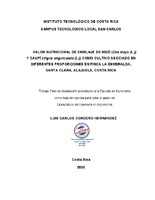Valor nutricional de ensilaje de maíz (Zea mays (L.)) y caupí (Vigna unguiculata (L.)) como cultivo asociado en diferentes proporciones en finca la Esmeralda, Santa Clara, Alajuela, Costa Rica
Abstract
El objetivo del presente trabajo fue evaluar la producción y valor nutricional de un ensilaje a base de maíz y caupí sembrados en asocio a diferentes proporciones: 100% maíz para el tratamiento T1, 70% maíz y 30% caupí para el tratamiento T2 y 60% maíz y 40% caupí para el tratamiento T3. Se establecieron cinco repeticiones por tratamiento, se pesó el material para determinar la producción de biomasa y materia seca, se ensilo en bolsas de 100 kg. Transcurriendo 30 días se abrieron las bolsas y se tomaron muestras para evaluar la calidad nutricional del material ensilado, calidad fermentativa, propiedades organolépticas con panel sensorial, pH, PC, Cenizas, %MS, FND y FAD con pruebas bromatológicas en laboratorio. Los resultados obtenidos muestran que la producción de biomasa de maíz fue alta en todos los tratamientos, alcanzando 41,5 t ha-1 en densidades de siembra de 66 000 pl ha-1 en el tratamiento de solo maíz y sin encontrar diferencias significativas entre los cultivos sembrados en asocio (maíz: caupí). En producción de biomasa de caupí se encontraron diferencias altamente significativas entre los tratamientos de maíz sembrado en asocio con caupí, teniendo producción muy por encima el tratamiento con 60%maiz y 40% caupí, con 2,3 t ha-1. Las diferencias fueron no significativas en la producción de %MS entre los ensilajes obtenidos de los cultivos sin importar la proporción de siembra. Los datos del panel sensorial indicaron que los ensilajes obtenidos de los cultivos sin importar la proporción de siembra tuvieron una fermentación correcta, con color amarillo, olor agradable y texturas deseadas, con valores de pH dentro del rango deseado (3,5 a 4,5). Se encontraron diferencias altamente significativas en cuanto al N-Total (T3 2,03%, T2 1,84% y T1 1,68%) y Proteína (T3 12,67%, T2 11,50% y T1 10,49%), en Cenizas (T3 7,10%, T1 6,41% y T2 6,39%) y en FDN (T1 62,86%, T3 60,24% y T2 59,65%). Las diferencias fueron no significativas en FDA (T1 36,46%, T3 34,97% y T2 33,44%). The objective of this work was to evaluate the production and nutritional value of silage based on corn and cowpea sown in association with different proportions: 100% corn for the T1 treatment, 70% corn and 30% cowpea for the T2 and 60% treatment corn and 40% cowpea for the T3 treatment. Five repetitions per treatment were established, the material was weighed to determine the production of biomass and dry matter, it was ensiled in 100 kg bags. After 30 days, the bags were opened and samples were taken to assess the nutritional quality of the silage material, fermentative quality, organoleptic properties with sensory panel, pH, PC, Ash, % MS, FND and FAD with bromatological tests in the laboratory. The results obtained show that the production of corn biomass was high in all treatments, reaching 41.5 t ha-1 in planting densities of 66 000 pl ha-1 in the treatment of only corn and without finding significant differences between crops planted in association (corn: cowpea). In production of cowpea biomass, highly significant differences were found between treatments of corn planted in association with cowpea, with production far above the treatment with 60% corn and 40% cowpea, with 2.3 t ha-1. The differences were not significant in the production of% DM between the silages obtained from the crops regardless of the sowing proportion. The data from the sensory panel indicated that the silages obtained from the crops regardless of the sowing proportion had a correct fermentation, with yellow color, pleasant smell and desired textures, with pH values within the desired range (3.5 to 4.5 ). Highly significant differences were found regarding N-Total (T3 2.03%, T2 1.84% and T1 1.68%) and Protein (T3 12.67%, T2 11.50% and T1 10.49% ), in Ashes (T3 7.10%, T1 6.41% and T2 6.39%) and in FDN (T1 62.86%, T3 60.24% and T2 59.65%). The differences were not significant in FDA (T1 36.46%, T3 34.97% and T2 33.44%).
Description
Proyecto de Graduación (Licenciatura en Ingeniería en Agronomía) Escuela de Ingeniería en Agronomía, Instituto Tecnológico de Costa Rica, 2020


